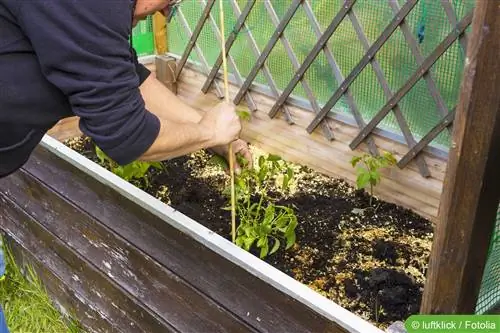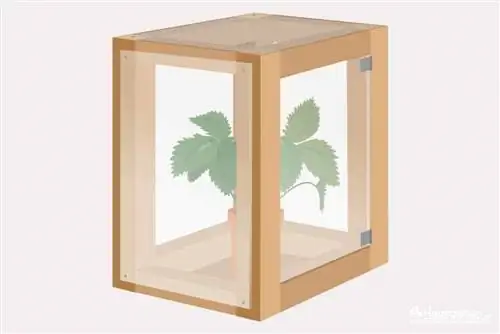- Author admin [email protected].
- Public 2023-12-17 03:39.
- Last modified 2025-01-24 12:45.
A trellis is ideal for decoratively displaying tendrils and climbing plants. So that climbing artists such as roses, clematis and colleagues can celebrate their art on the balcony or terrace, the combination with a planter is a great advantage. This means that facades, pergolas or fences that are not directly adjacent to the ground should also be covered in greenery. With a little craftsmanship, hobby gardeners can construct a tailor-made solution made of wood. The following DIY instructions show you how to build a plant box with a trellis yourself.
Material list for the planter box
In a nature-loving garden, wood is the primary choice for building a planter with an integrated climbing frame. Although all pressure-impregnated garden woods are suitable, types of wood such as pine, spruce and larch are particularly recommended as thermowood. To improve durability, this garden wood undergoes thermal treatment at 170 to 230 degrees Celsius, so it is defined as thermowood. If the financial budget for purchasing materials is a little more generous, there is of course nothing to be said against using teak, Douglas fir or another tropical wood. To build the container the following materials are required:
- 8 longitudinal strips measuring 2.5 x 9.4 x 115 cm
- 8 crossbars measuring 2.5 x 9.4 x 40 cm
- 3 floor boards measuring 2.5 x 9.4 x 120 cm
- 4 corner posts measuring 4.5 x 7 x 115 cm
- 3 skirting boards in dimensions 4.5 x 7 x 40 cm
- 2 transport swivel castors with or without brakes
- 1 piece of pond liner measuring 1.5 sqm x 1.2 mm thick
- 1 piece of drainage fleece with an area of 0.5 sqm
- and stainless steel screws
DIY instructions for the planter box
The frame is made up of 4 opposing longitudinal and transverse strips. These are stabilized at the corners by an upright corner post and connected with stainless steel screws. The longitudinal boards are 115 cm long and the cross boards are 40 cm long. The bottom of the planter is made up of 3 boards with a length of 120 cm. These are screwed at a distance of 2 cm so that excess irrigation water can drain away unhindered and no waterlogging occurs. The 3 skirting boards also ensure good ventilation from below. In addition, you can optionally install wheels here to give the planter mobility. When choosing the swivel castors, please make sure that they can handle a weight of at least 125 kg.
Finally, the finished plant box is lined on the inside with pond liner, which has holes in several places. Alternatively, use a suitable plastic insert, which is ideally purchased before the planter is built so that the dimensions can be adjusted if necessary. Here, attention should also be paid to a sufficient number of floor openings so that water can drain away.
Material list for the trellis
So that the wooden box and trellis form a harmonious unit, the same type of wood should be used for both components. These materials are required:
- 4 vertical frame strips 2.5 x 6.0 x 120.0 cm
- 4 horizontal frame strips 2.5 x 6.0 x 100.0 cm
- 2 vertical frame strips 2.5 x 3.0 x 120.0 cm
- 2 horizontal frame strips 2.5 x 3.0 x 120.0 cm
As the later DIY instructions for the individual construction steps show, you create a total of 3 frames. The lattice framework is clamped between two frames of the same size and firmly clamped by a third, smaller frame. This creates a high degree of stability, so that you can also use powerful climbing plants or berry bushes in the planter.
The following strips must be purchased for the trellis between the frames:
- 2 strips 2, 5 x 6, 0 x 26, 0 cm
- 2 strips 2, 5 x 6, 0 x 35, 0 cm
- 2 strips 2, 5 x 6, 0 x 52, 0 cm
- 2 strips 2, 5 x 6, 0 x 60, 0 cm
- 2 strips 2, 5 x 6, 0 x 76, 0 cm
- 2 strips 2, 5 x 6, 0 x 85, 0 cm
- 2 strips 2, 5 x 6, 0 x 105, 0 cm
- 2 strips 2, 5 x 6, 0 x 110, 0 cm
- 2 strips 2, 5 x 6, 0 x 126, 0 cm
- 2 strips 2, 5 x 6, 0 x 136, 0 cm
- 2 strips 4.5 x 7.0 x 147.6 cm for attachment to the plant box
- Stainless steel screws
Build a frame for the trellis
The two outer frames of the trellis are made up of 2 strips each with a length of 120 cm and 100 cm. Screw the smaller frame with a width of 3.0 cm onto one of these two frames so that the outer edges of both frames are flush with each other. In this way you create a support surface for the grid construction inside. To do this, it is necessary to butt (shorten) the inner frame so that the crossbars will later be 114 cm long and the vertical slats will be 100 cm long.
Instructions for frame corner connections
Securely connecting the frame corners is probably the biggest hurdle for most DIY enthusiasts. Since the trellis will not be exposed to heavy loads, the simplest variant of a frame corner connection can be considered: leafing. How to do it right:
- Saw out half of the frame thickness and frame width alternately
- The resulting connection is glued with wood glue
- Pins or screws provide additional stability
Alternatively, a doweled connection is an option. The frames can be doweled together either bluntly, with or without tenons. It is important to note that the drill works precisely when drilling the dowel holes and does not run. Otherwise, when assembling the frames, there is a risk of a skewed position, which is difficult to correct.
Build trellis
Now construct the grid by placing the 2.5 cm thick and 6 cm wide strips in the frame and cutting them to the appropriate length. Place the second layer on top of the first layer in a cross pattern. Where the two layers of strips cross each other, mark the places as precisely as possible, as this is where you will be sawing out the marked pieces of wood in such a way that a stable cross connection is created. To do this, lay out the marked slats so that they can be processed with a fine saw. A perfect notch is exactly half as deep as the wooden slat is high. The width of the notch corresponds exactly to the width of the batten. Now all the strips can be put together to form the desired lattice structure, clamped between the two frames and screwed together. The third frame can now be put on and fixed with the stainless steel screws.
Attach the trellis to the planter box
In order to connect the trellis and the wooden container, the two strips measuring 4.5 x 7 x 147.6 cm are now used. Screw these strips onto the wide side of the box so that the lower edge of the strip is flush with the lower edge of the planter. The trellis is inserted between the two fastening slats so that the upper edges are also flush. With these dimensions there is a distance of 10 cm between the plant box and the grid. If you want a greater distance, the length of the strips must be changed accordingly.
Conclusion
A planter box with an integrated trellis creates a decorative eye-catcher on the balcony, terrace and in the garden. At the same time, this variant serves as a practical and nature-loving privacy screen or contributes to the greening of facades where the floor is sealed or paved. Skilled hobby gardeners don't miss the opportunity to create this construction themselves. These DIY instructions show you how to build a tailor-made plant box with a trellis yourself. The dimensions mentioned may serve as a guide and must be adjusted individually. The total of 3 frames provide an extra dose of stability. The two outer frames are the same size and clamp the trellis, while it is firmly clamped in the third, smaller frame.






